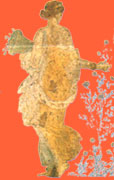|
 Among
the collections just the one of the precious stones
inherited by the Medici belongs almost entirely
to the Farnese family. During the excavations
at Caracalla baths and at the Palatino in Rom,
Farnese collected many sculptures. The other collections
in the museum are made of what found in the excavations
and of what bought at the antiquarian marcket.
The bronze statues, the frescoes, the bronze,
iron, fired-clay, glass, bone, avory furnishings
and the majority of golden and Silver objects
come from Ercolano and Pompei. Among
the collections just the one of the precious stones
inherited by the Medici belongs almost entirely
to the Farnese family. During the excavations
at Caracalla baths and at the Palatino in Rom,
Farnese collected many sculptures. The other collections
in the museum are made of what found in the excavations
and of what bought at the antiquarian marcket.
The bronze statues, the frescoes, the bronze,
iron, fired-clay, glass, bone, avory furnishings
and the majority of golden and Silver objects
come from Ercolano and Pompei.
The bronze collection is wonderful; many of them
were found in the Villa dei Papiri in Pompei (as
the "Apollo with the cithara" coming
from the so called Citharist House).
The museum contains the best of furnishings (silver,
precious crockery, vases, oil-lamps, braziers,
candelabrums, bilances, surgical instruments)
from the Pompei houses. From Pompei and Ercolano
comes also the collection of mosaics. The mosaic
of the Battle of Alessandro against Dario is beautiful,
but also the most popular scenes as the one of
the enchantress consultation and the concert of
wandering musicians.
Also the painting collection from Pompei, Ercolano
and Stabia is very important.  The
frescoes removal deprived excavations houses,
their move to the museum garanteed a better preservation
and defended them from the atmospheric agents.
In the museum you may see funeral paintings or
those paintings coming from private houses; they
have heroic or mythologic subjects, they are landscapes
or stll-lives. The
frescoes removal deprived excavations houses,
their move to the museum garanteed a better preservation
and defended them from the atmospheric agents.
In the museum you may see funeral paintings or
those paintings coming from private houses; they
have heroic or mythologic subjects, they are landscapes
or stll-lives.
They let us understand the customs of that times.
Other objects come from the excavations in Cuma,
Capua, Pozzuoli, Sorrento, Nola, Baia, Formia,
Paestum and from the necropolis in Southern Italy.
Meaningful the jewel collectiions, glazed fire-clays
and avory; among them it is important the Farnese
Cup.
As you may understand, the visit to the National
Museum is necessary once in the city, as the Museum
is a casket for the Mediterranean art and culture.
|




 Among
the collections just the one of the precious stones
inherited by the Medici belongs almost entirely
to the Farnese family. During the excavations
at Caracalla baths and at the Palatino in Rom,
Farnese collected many sculptures. The other collections
in the museum are made of what found in the excavations
and of what bought at the antiquarian marcket.
The bronze statues, the frescoes, the bronze,
iron, fired-clay, glass, bone, avory furnishings
and the majority of golden and Silver objects
come from Ercolano and Pompei.
Among
the collections just the one of the precious stones
inherited by the Medici belongs almost entirely
to the Farnese family. During the excavations
at Caracalla baths and at the Palatino in Rom,
Farnese collected many sculptures. The other collections
in the museum are made of what found in the excavations
and of what bought at the antiquarian marcket.
The bronze statues, the frescoes, the bronze,
iron, fired-clay, glass, bone, avory furnishings
and the majority of golden and Silver objects
come from Ercolano and Pompei. The
frescoes removal deprived excavations houses,
their move to the museum garanteed a better preservation
and defended them from the atmospheric agents.
In the museum you may see funeral paintings or
those paintings coming from private houses; they
have heroic or mythologic subjects, they are landscapes
or stll-lives.
The
frescoes removal deprived excavations houses,
their move to the museum garanteed a better preservation
and defended them from the atmospheric agents.
In the museum you may see funeral paintings or
those paintings coming from private houses; they
have heroic or mythologic subjects, they are landscapes
or stll-lives.